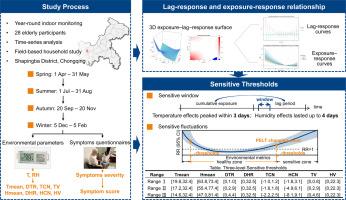Sensitive thresholds of indoor temperature-humidity on arthritis in older adults: A year-round cohort time-series study with PELT change-point detection
IF 7.6
1区 工程技术
Q1 CONSTRUCTION & BUILDING TECHNOLOGY
引用次数: 0
Abstract
Sudden temperature and humidity shifts may trigger or worsen arthritis symptoms in older adults. However, indoor environmental exposure thresholds remain unclear. This study followed 28 elderly adults with osteoarthritis in Chongqing for one year, recording joint symptoms and indoor climate conditions. We used distributed lag non-linear models (DLNM) and generalized linear models (GLM) to assess how eight indoor environmental indicators—mean temperature (Tmean), mean humidity (Hmean), diurnal temperature range (DTR), diurnal humidity range (DHR), temperature change between neighboring days (TCN), humidity change (HCN), temperature variability, and humidity variability (HV)—affect symptoms over time. We used the Pruned Exact Linear Time (PELT) algorithm to detect change points and define three-level sensitivity thresholds. Results showed that rapid or unusual changes in indoor temperature and humidity increased joint pain risk. Risks were highest in autumn and winter when indoor conditions fluctuated sharply. Temperature-related symptoms appeared mostly within three days; humidity-related effects within four days. We identified the following acceptable sensitivity thresholds (Level Ⅲ): Tmean [14.6 °C, 32.4 °C]; DTR <4.4 °C; TCN [-2.2 °C, 2.5 °C]; TV <4.6 °C; Hmean [47.0 %, 81.4 %]; HCN [-8.1 %, 9.1 %]. DHR and HV showed no clear limits. Fluctuations beyond these values were more likely to worsen symptoms. Levels Ⅰ and Ⅱ exhibit progressively narrower threshold ranges, with Level Ⅰ representing the optimal zone in which symptom risk is minimal. These findings provide clear and quantified reference points for indoor climate control to help manage arthritis symptoms in older adults.

室内温湿度对老年人关节炎的敏感阈值:一项使用PELT变化点检测的全年队列时间序列研究
突然的温度和湿度变化可能引发或加重老年人的关节炎症状。然而,室内环境暴露阈值仍不清楚。本研究对重庆地区患有骨关节炎的28名老年人进行了为期一年的随访,记录关节症状和室内气候条件。我们使用分布滞后非线性模型(DLNM)和广义线性模型(GLM)来评估八个室内环境指标——平均温度(Tmean)、平均湿度(Hmean)、日温度范围(DTR)、日湿度范围(DHR)、相邻天之间的温度变化(TCN)、湿度变化(HCN)、温度变异性和湿度变异性(HV)——如何随时间影响症状。我们使用精确线性时间(PELT)算法来检测变化点,并定义了三级灵敏度阈值。结果表明,室内温度和湿度的快速或异常变化增加了关节疼痛的风险。秋季和冬季室内条件波动剧烈,风险最高。与温度有关的症状大多在三天内出现;4天内与湿度有关的影响。我们确定了以下可接受的灵敏度阈值(水平Ⅲ):Tmean[14.6°C, 32.4°C];4.4°C;TCN[-2.2°c, 2.5°c];电视<;4.6°C;平均[47.0%,81.4%];HCN[- 8.1%, 9.1%]。DHR和HV无明显限制。超过这些值的波动更有可能使症状恶化。级别Ⅰ和Ⅱ的阈值范围逐渐缩小,级别Ⅰ代表症状风险最小的最佳区域。这些发现为室内气候控制帮助老年人控制关节炎症状提供了明确和量化的参考点。
本文章由计算机程序翻译,如有差异,请以英文原文为准。
求助全文
约1分钟内获得全文
求助全文
来源期刊

Building and Environment
工程技术-工程:环境
CiteScore
12.50
自引率
23.00%
发文量
1130
审稿时长
27 days
期刊介绍:
Building and Environment, an international journal, is dedicated to publishing original research papers, comprehensive review articles, editorials, and short communications in the fields of building science, urban physics, and human interaction with the indoor and outdoor built environment. The journal emphasizes innovative technologies and knowledge verified through measurement and analysis. It covers environmental performance across various spatial scales, from cities and communities to buildings and systems, fostering collaborative, multi-disciplinary research with broader significance.
 求助内容:
求助内容: 应助结果提醒方式:
应助结果提醒方式:


